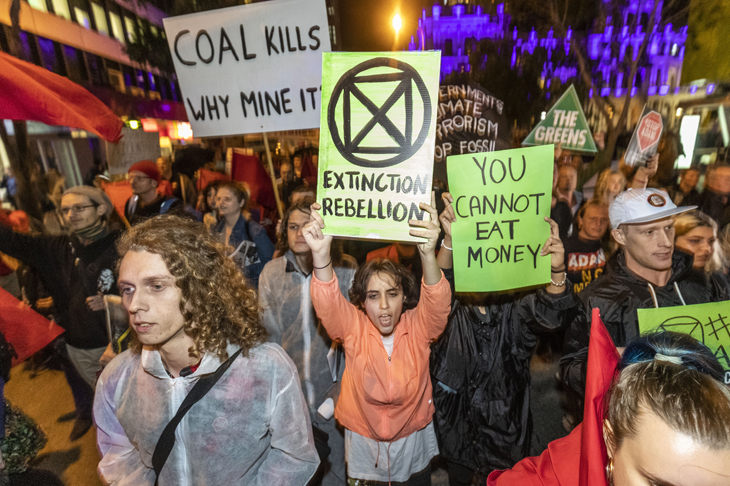It’s a legal double-whammy, especially for the resources sector. ‘Perceived bias’ in the Australian judiciary on the one hand and, on the other, the fact that Australians don’t trust environment law anyway.
That’s what two current federal enquiries, one into judicial bias and another into unsatisfactory environmental laws, are now indicating. And these two issues are conjoined as the government is having to appeal yet another activist judge’s intervention into the parliament’s role of determining the nation’s environment policy. As reported recently on this page, Justice Bromberg’s Federal Court decision that the ‘undoubted likelihood’ of young people’s deaths from climate change due to greenhouse gas emissions imposes a duty of care on governments that must be met when deciding development approvals. This has serious economic implications unless reversed; the government has announced an appeal, with Energy Minister Angus Taylor asserting ‘we don’t think it’s appropriate for the courts to take over the role of Government in making these difficult important decisions’. To add to these interweaving concerns, a survey commissioned by the Menzies Research Centre (and submitted to the Australian Law Reform Commission’s bias enquiry and released last week) has found that ‘82 per cent of Australians are concerned that judges may be making decisions based on motives other than a strict interpretation of the law’.
The ALRC, appointed last September, is to report within the next two months on: what reform is needed to the laws relating to judicial impartiality and bias; whether the existing law about actual or apprehended bias relating to judicial decision-making remains appropriate and sufficient to maintain public confidence in the administration of justice; and is existing law sufficiently clear and appropriate for raising and deciding allegations of actual or apprehended bias?
In its guidance paper, the ALRC pointed to the sort of problems it was seeking to solve – many of which, particularly judgements relating to greenhouse gas emissions, have been the subject of critical comment in these pages. ‘An apprehension of bias may arise if a judge’s comments or behaviour suggest that the matter has been subject to prejudgment. Such a finding will arise where “an independent observer might reasonably apprehend that the decision-maker might not be open to persuasion…”. Extra-judicial writing may raise issues of prejudgment, if a judge expresses ‘‘preconceived views which are so firmly held” that the hypothetical observer may think it might not be possible for them to approach cases with an open mind’. This was the basis of media criticism of NSW judge Brian Preston’s controversial decision to reject a mining development on the basis of potential greenhouse gas emissions mainly by overseas consumers of the coal to be mined. And the ALRC adds that ‘In some cases, litigants have used a judge’s prior record of decisions (including by use of statistics) to argue that the judge is predisposed to certain views about particular types of cases or litigants and that it is impossible for the judge to hear the case with an open mind’.
This is the context in which the MRC submitted its analysis of the 109 relevant Industrial Relations substantive law decisions made by 33 justices of the Federal Court of Australia over the period from 1 July 2018 to 1 July 2020, in which unions and employers shared the overall outcomes almost equally. But in the eleven cases heard by Labor-appointed Justice Bromberg he has found in favour of the union ten times – 91 per cent, far higher than the five other ‘above average’ jurists.
And the MRC submission noted that in one of the five decisions involving Justice Bromberg on industrial relations matters that have been overturned by the High Court, it stated that his judgement ‘gives rise to absurd results and inequitable outcomes and would be contrary to the legislative purposes of the Fair Work Act’, while another appeal court in ‘emphatically rejecting’ Justice Bromberg’s reasoning, added that ‘conclusions of this kind reflect value judgments rather than legal conclusions’. His decision against Andrew Bolt on racial prejudice attracted widespread similar criticism.
But the most concerning element of the MRC submission relates to the increasing use of the courts by environmental activists, as in the recent controversial case before Justice Bromberg. The MRC’s submission ‘is made at a time when there is increasing use of the courts for political purposes. Activist groups, pursuing specific agendas, have identified, promoted and resourced campaigns to employ the power of the courts for their purposes’. This phenomenon has been growing following a 2011 Greenpeace prospectus seeking financial support for ‘a campaign to end the Australian coal industry by using legal challenges that can stop projects outright, or can delay them in order to buy time to build a much stronger movement’. The MRC warns that if the trend continues and the courts are increasingly used as a vehicle for what are basically political campaigns it’s essential that the courts both maintain their independence and be seen to do so.
Compounding the legal uncertainty over emissions created by activist judges is the reality that Australia’s environmental law is a mess. The recent report of the Graeme Samuel-led enquiry into the Environment Protection and Biodiversity Conservation Act concluded that it is ‘out-dated and requires fundamental reform. It does not enable the Commonwealth to effectively fulfil its environmental management responsibilities to protect nationally important matters. Australians do not trust that the EPBC Act is delivering for the environment, for business or for the community…. There is widespread public perception that the environment is losing out to other considerations due to proponents having undue influence on decision-makers, while industry is also distrustful of the EPBC, viewing it as cumbersome, pointing to duplication, slow decision-making, and legal challenges being used as a tool to delay projects and drive up costs for business (“lawfare”)’. This explains the average of nearly three years to get approval for resource projects, with little additional environmental benefit. At least the Samuel review, which defends the ability of the public to hold decision-makers to account through the courts on development matters, as a fundamental foundation of Australia’s democracy, concedes that ‘Legal challenges should be limited to matters of outcome, not process, to reduce litigation that does not have a material impact on the outcome’.
In the meantime, the government’s appeal against the Bromberg ‘coal kills kids’ decision may only be the next stage of what could be a prolonged legal battle ending up in the High Court. Whether what Environment Law Australia describes as a ‘stunning, novel and ground-breaking decision, with enormous implications for future climate litigation, will survive appeal is uncertain. It may be that his construction of the EPBC Act and other aspects of his decision are a leap too far for the judges hearing the appeals’.
Let’s hope so.
Got something to add? Join the discussion and comment below.
Get 10 issues for just $10
Subscribe to The Spectator Australia today for the next 10 magazine issues, plus full online access, for just $10.
You might disagree with half of it, but you’ll enjoy reading all of it. Try your first month for free, then just $2 a week for the remainder of your first year.














Comments
Don't miss out
Join the conversation with other Spectator Australia readers. Subscribe to leave a comment.
SUBSCRIBEAlready a subscriber? Log in